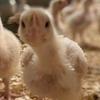Heat stress in poultry
Published: March 8, 2021
Source : Dr. Marisa Erasmus, Purdue University. Reviewers: Dr. Leonie Jacobs, Virginia Tech; Dr. Prafulla Regmi, North Carolina State University; Dr. Shawna Weimer, University of Maryland.

Identifying behavioral signs is key to managing heat stress in poultry
Every year, high summer temperatures have important effects on poultry health and welfare. Heat stress occurs when poultry cannot adapt to high environmental temperatures and need to expend energy to maintain their body temperature within the ideal range.
Heat stress can be a problem for any poultry and can affect birds at any age. In addition, heat stress can affect birds in any environment, including indoor or outdoor production systems, backyard environments, at county and state fairs, and during transportation.
The ideal temperature range for most poultry lies between 15 and 24°C (60 and 75°F). The ideal temperature depends on amount of feather cover, age and body weight of the bird.

Costs and consequences of heat stress
Heat stress costs the US poultry industry millions of dollars every year. The consequences of heat stress can be severe, leading to death in extreme cases.
For meat birds, heat stress can reduce meat quality and for egg laying birds, heat stress can result in a drop in egg production and reduced egg quality, including thin egg shells.
High environmental temperatures, combined with high levels of humidity, can be even more problematic.
Recognizing when poultry are at risk of heat stress and identifying heat stress are important in protecting bird health and welfare.
Effects of heat stress on poultry
Heat stressed birds:
- Do not grow/develop as well
- Are not as efficient at using feed
- Are less effective at fighting disease
- May pose risks to food safety
Behavioral signs of heat stress
Unlike mammals, poultry lack sweat glands, and behavioral mechanisms are critical for maintaining a stable body temperature.
Behavioral signs to look for:
- Drinking more water than usual
- Eating less than usual
- Less active than usual
- Sitting or lying with wings spread out
- Panting
- Seeking out cooler areas, such as lying underneath drinkers
- Isolating themselves or moving away from other birds in the flock

Reducing risks of heat stress
- Poultry should have access to fresh, clean and cool (not frozen/hot) water at all times
- Increase air flow and ventilation
- Provide shaded areas for poultry kept outdoors
- Reduce stocking density in warm and hot weather (provide more space per bird)
- Reduce additional stress on birds if possible, such as catching, loading and transporting
- If birds do need to be caught and transported, plan to do these activities during the coolest parts of the day
- Make sure all workers are trained to recognize and monitor birds for signs of heat stress

This article was originally published on Poultry Extension Collaborative (PEC) and it is reproduced here with permission from the authors.
Additional resources
- Department for Environment, Food and Rural Affairs (UK). Heat stress in poultry solving the problem.
- Pawar et al. 2016. Assessing and mitigating the impact of heat stress in poultry. Advances in Animal and Veterinary Sciences. 4: 332-341. doi: Http://dx.doi.org/10.14737/journal.aavs/2016/4.6.332.341.
- PoultryDVM.com. Heat Stress.
- Reddy, E. and Ramya, P. 2015. Heat stress strategies for layers in hot climates. WATTAgNet.com.
- University of Minnesota Extension. Preventing heat stress in poultry.
- University of Nebraska-Lincoln Extension. Heat stress management in broilers.
Related topics:
Mentioned in this news release:




Show more
Recommend
Comment
Share

23 de marzo de 2021
Hi! Without knowing too much about your specific poultry system, I would say that ventilation would be a key management approach to avoid heat stress in poultry. High levels of air flow will reduce heat stress even if temperatures are quite high. Another potential approach could be to cool the water that birds have access to, but this may not be feasible. Hope this helps!
Recommend
Reply
5 de abril de 2021
Inspite of all management regarding heat stress, we can use kcl to ago d the effect of heat stress. We can use 2-3 g of KCl per liter of water.
Recommend
Reply
1 de abril de 2021
Please discuss heat stress in poultry especially if you are in a tropical country where temperature reaches up to 42°C in the afternoon. Thanks and stay safe everyone
Recommend
Reply
23 de marzo de 2021
Thanks Authors for information, now how can I control heat in the poultry house particularly in African tropical countries
Recommend
Reply
Recommend
Reply

Would you like to discuss another topic? Create a new post to engage with experts in the community.



















